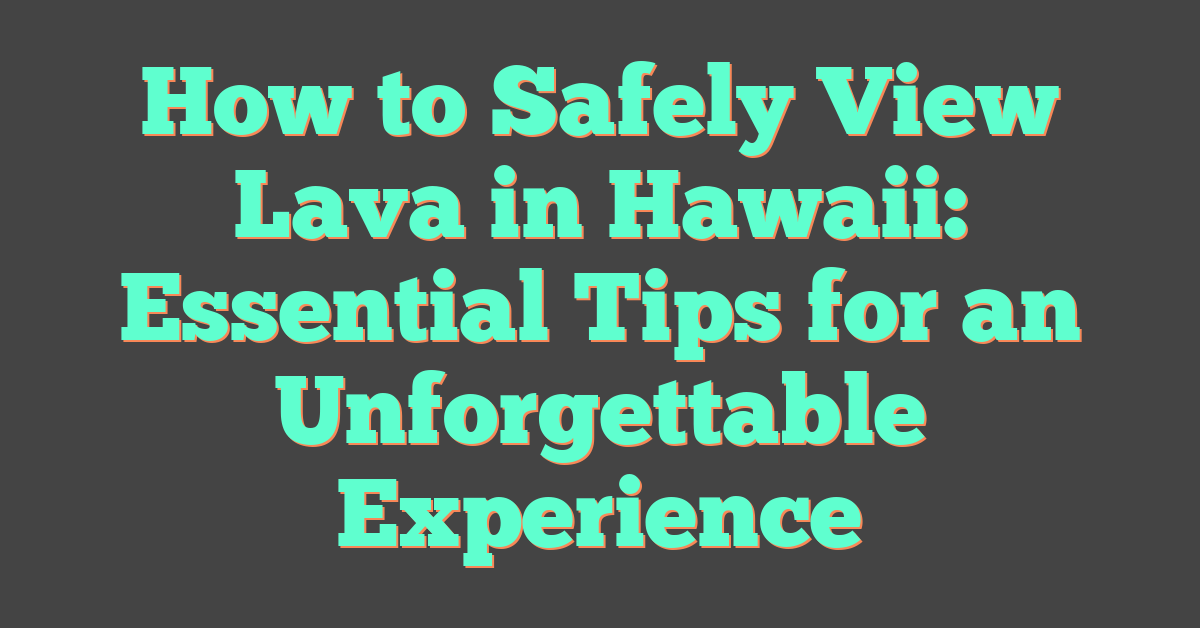Watching lava in Hawaii is something I’ll never forget. The glowing rivers and bubbling lava amaze me, but they can also be dangerous if I’m not careful.

The best way to view lava in Hawaii is to follow park rules, listen to local experts, and keep a safe distance from active flows. Staying alert and respecting guidelines helps keep everyone safe.

Lava viewing areas in Hawaii change every day, depending on volcanic activity and weather. I always check for updates and use official resources to see which lookouts are open and safe.
Park rangers close certain spots if they aren’t secure. Popular areas often attract crowds, so I plan my visit during less busy hours when possible.
Exploring the volcanoes teaches me to respect both the power of nature and local traditions. I come prepared, stay aware, and remember that this is a sacred place for many people.
For more details, I look up current guidance and safety tips at the Hawaii Volcanoes National Park eruption viewing guide.
Understanding Lava and Volcanoes in Hawaii
Hawaii is famous for its active volcanoes and striking lava flows. Learning how these volcanoes work and how lava moves helps me stay safe and enjoy my visit.
Types of Volcanoes Found in Hawaii
Most volcanoes in Hawaii are shield volcanoes. These mountains have broad, gently sloping sides because thin lava flows easily and spreads out.
Mauna Loa and Mauna Kea are the biggest and most well-known shield volcanoes on the Big Island. Unlike stratovolcanoes, which erupt explosively, Hawaiian shield volcanoes erupt slowly and quietly.
This makes them safer to observe than other volcanoes around the world. Over thousands of years, thin layers of molten lava cool and harden to build these volcanoes.
The slow, steady movement of lava shapes Hawaii’s unique landscape. If I want to learn more about Hawaii’s shield volcanoes, I check out this complete guide to Hawaii’s volcanoes.
How Lava Flows Form
Molten rock escapes from cracks or vents in the earth’s surface to create lava flows. In Hawaii, most lava is basaltic, which is hot, runny, and can travel long distances before cooling.
The flows often move slowly, so I can see their bright, glowing paths from safe spots. Sometimes, lava pours out in steady streams and forms new land as it cools.
Other times, lava builds up in pools or moves beneath the surface in tunnels called lava tubes. Watching a lava flow lets me see the earth creating new land right before my eyes.
I stay safe and follow park rules because the flow’s path and speed can change quickly.
Volcanic Activity on the Big Island
The Big Island has the most active volcanoes in Hawaii. Kilauea and Mauna Loa have both erupted in recent years and attract visitors from all over the world.
Sometimes, I can see lava at Halemaʻumaʻu crater in Hawaii Volcanoes National Park. Kilauea’s activity can change quickly, and the lava lake inside the crater can appear or disappear in just a few days.
Park staff and the U.S. Geological Survey track volcanic events every day and keep visitors updated. I always check the latest alerts before planning any lava viewing trip on the Big Island.
Where to Safely View Lava
Lava viewing on the Big Island can be both thrilling and dangerous. I make sure to use official spots and follow safety rules to enjoy Hawaii’s active volcanoes safely.
Hawai’i Volcanoes National Park Overview
When I want to see active lava, I visit Hawai’i Volcanoes National Park. This park gives me access to Kīlauea and Mauna Loa, two of the world’s most famous active volcanoes.
Park staff keep visitors safe by posting alerts and closing dangerous areas. The visitor center has the latest updates on volcanic activity and safe trails.
I start my trip here to ask about open viewing spots. Park rangers sometimes guide short hikes if conditions allow.
There are easy walks for families and more challenging hikes for adventurers. I find maps at the entrance or online.
The park opens and closes areas based on safety. Before I go, I check park alerts and the latest maps on the National Park Service eruption viewing page.
Kīlauea and Mauna Loa
Kīlauea is usually the best spot for seeing lava up close. In 2025, the most active area is the Halemaʻumaʻu Crater at Kīlauea’s summit.
At night, the glow from fresh lava is often visible, which is an unforgettable sight. Sometimes, eruptions pause or start again, so timing matters.
Mauna Loa is also active but erupts less often and may not always have visible lava. My best experiences happen when I plan ahead and check for real-time updates.
Park staff and the U.S. Geological Survey give the latest news. Sometimes eruptions are not safe to view, or lava activity is low, so I keep my plans flexible.
Up-to-date information is on Hawaii Volcano eruption tracking guides.
Designated Lava Viewing Areas
Only the park’s designated lava viewing spots are safe and legal for visitors. Park rangers rope off areas and post signs to keep me at a safe distance and protect fragile lava formations.
The allowed viewing distance can change, sometimes set as far as 1/2 mile away when activity is high. Rangers use visual checks and thermal imaging to decide what’s safe.
Crowds gather at popular sites, and there may be waits to enter viewing areas, especially during eruptions. I bring water, a flashlight, and sturdy shoes since trails can be dark and rocky.
Park guidelines stress staying within marked zones for safety. I always look at maps and safety alerts before heading out.
For updates, the Big Island Lava Viewing Guide explains safe viewing distances and current open sites.
Best Ways to Experience Lava Safely
When I want to see lava in Hawaii, I always think about safety and comfort first. There are a few main ways to enjoy this adventure: joining a guided tour, hiking on my own, or seeing the lava from above.
Guided Lava Tours
Booking a guided lava tour helps me explore safely without worrying about getting lost. Guides know the current lava activity and the safest spots.
Some tours provide helmets, gloves, and flashlights. Guides keep me away from danger and answer my questions during the walk.
Guided tours work well for families or first-timers. The guide shows me how to walk on rough lava rock and reminds me to bring water and sunscreen.
Some tours even offer boat rides when lava flows into the ocean, which is an amazing view. Guides also handle permits when needed.
These tours make the experience easier by planning everything. If I want a safe and informative trip, guided lava viewing is my top choice.
Independent Hiking Tips
If I decide to explore on my own, I plan ahead. I check for eruption updates and trail closures online before heading out.
The lava landscape changes fast, so I never hike alone or after dark. I wear good shoes and bring a flashlight since the rocky terrain is sharp and uneven.
Packing plenty of water is very important, as the black lava fields get hot under the sun. I layer my clothes and use sunscreen to avoid sunburn.
I pay attention to signs and respect barriers set by park rangers. Having extra snacks and a fully charged phone helps, and telling someone about my route keeps me safer.
Independent hiking lets me enjoy the adventure at my own pace when I’m prepared.
Viewing Lava from the Air
Seeing lava from a helicopter lets me watch volcanic activity from a safe distance. Flight operators know which routes give the best views of active flows and craters.
This way, I avoid the risks of hiking on unstable lava or breathing volcanic gases too closely. Aerial tours give me a view that’s impossible to get from the ground.
I can see how far the lava spreads and even spot new eruption sites. Pilots usually explain what I’m seeing and point out the safest places.
I pick a tour company with experienced pilots and a good safety record. Booking an aerial tour is a smart choice if I want a memorable view of the lava while staying safe and comfortable.
Understanding and Managing Volcanic Hazards
When I visit lava flows in Hawaii, I know it’s not just about seeing something amazing. I also need to keep myself safe from hidden dangers like volcanic gases, heat, and getting too close to flowing lava.
Volcanic Gases and Air Quality
I pay close attention to volcanic gases, especially sulfur dioxide, which is common near active vents. When sulfur dioxide mixes with other elements in the air, it forms volcanic smog, called vog.
Vog can make it hard to breathe, cause eye irritation, and bother people with asthma or other lung problems. I check air quality updates before heading out.
I use park websites or listen to local alerts for the latest conditions. If vog levels are high, I bring a mask or cloth to cover my nose and mouth.
I stay upwind from active vents and avoid low spots where gases settle. If I start to feel dizzy or have trouble breathing, I leave the area right away.
For more on volcanic gas safety, I read the National Park Service information.
Managing Heat and Dehydration
When I stand near a lava flow, I feel intense radiant heat even from far away. Lava can reach temperatures well over 2,000°F (about 1,100°C).
The ground around recent flows also stays hot for a long time. I protect myself by wearing sturdy clothing, closed-toed shoes, and sometimes gloves.
The heat makes me sweat a lot and lose fluids faster than I expect. To avoid dehydration, I pack at least 2 liters of water, even for short hikes.
I take breaks in cooler, shaded areas when I find them. Sun hats and sunscreen help protect me from the extra heat of the sun and the lava.
I pay attention to early signs of dehydration, like a dry mouth or dizziness. I never ignore these warning signs.
Safe Distance from Lava
No matter how exciting lava looks, I never get too close to active flows. Even solid-looking surfaces can be unstable or dangerously thin.
The ground might break or collapse without warning, especially near ocean entries or new flows. Park guides recommend keeping at least several hundred feet away from any active breakout.
I always follow marked trails and respect warning signs. I listen to the advice of rangers and local experts.
For a safer experience, I carry a flashlight for night hikes and wear bright clothes. I let others know my plans.
A detailed lava-viewing guide for the Big Island offers more safety tips and explains why protective gear is so important.
Lava Features and Formations You May See
When I visit Hawaii to view lava, I see some of nature’s most interesting landforms. Each feature has its own sights, sounds, and safety rules to remember.
Lava Lakes and Tubes
A lava lake is an open pool of molten rock that glows bright orange and sometimes bubbles or spits. I find these lakes in volcanic craters or vents.
The lava’s surface looks shiny and smooth at first but forms a crusty layer as it cools. Lava tubes are like underground tunnels formed by flowing lava.
When the outer part of a flow cools and hardens while the inside stays hot and moving, a tube forms. These tubes can be long, winding passageways beneath solid ground.
What I always remember:
- Never explore a lava tube alone.
- Watch my step closely inside tubes, as surfaces may be uneven or slippery.
Some famous tubes, like those in Volcanoes National Park, have safe pathways for visitors. To learn more, I visit the Volcanoes National Park’s lava formation guide.
New Land and Ocean Entry
When lava reaches the ocean, it cools quickly and hardens. This process creates brand new land along the shoreline.
Seeing fresh black sand or new rock forming at the water’s edge amazes me. This helps me understand how the islands keep growing.
Standing too close to fresh “ocean entry” is dangerous. The new ground can look stable but may actually be weak and collapse under my feet.
The heat from the lava meeting the ocean makes the area very hot. I also watch out for waves and sharp lava edges.
A map or a ranger’s advice helps me know where new land or ocean entries are safe and legal to view. For tips, I check Big Island’s updated lava viewing info.
Steam Plumes and Laze
When hot lava pours into the cold ocean, thick white steam plumes rise up. This steam is called “laze,” which stands for lava haze.
Laze is not just regular steam; it contains hydrochloric acid and tiny volcanic glass particles. These are dangerous to breathe.
Even standing downwind makes my eyes and throat burn. I always check which way the wind is blowing before I watch an ocean entry.
Some helpful viewing tips:
- I never get too close to the laze.
- I use a mask or cover my face if I’m near steam plumes, even for a short time.
Rangers often block off unsafe zones if laze is blowing onshore. For more details, I check the latest safety guides at Far and Away Adventures’ lava safety tips.
Essential Safety Guidelines for Visitors
Before I set out to watch lava in Hawaii, I always prioritize my safety. I make sure I’m prepared for changing volcanic conditions and the sharp landscape.
Planning helps keep my visit safe. I check eruption updates from the USGS Hawaiian Volcano Observatory before heading out.
They share up-to-the-minute changes about eruptions and activity levels. I also pay attention to park alerts and posted signs that warn me of closed trails or high-risk spots.
If conditions suddenly change, officials might close off certain viewing areas. I follow their advice and turn back when needed.
Using real-time information keeps me informed and helps me react if something changes quickly. I always check the park website for current volcano safety tips and alerts before I visit.
Understanding Explosions and Hazards
Volcanoes like Kīlauea and Mauna Loa can behave in unpredictable ways. Explosions may happen with little warning, bursting hot gas, rock, and ash into the air.
I stand far back from active flows and avoid venturing onto older, unstable lava. Even solid-looking ground can hide dangerous cracks or thin crusts.
Hazard signs mean serious business. I never cross boundaries or leave marked trails.
Lava tubes and sharp, jagged rocks can cause injury. Even steam vents and old flows can burn or break under my feet.
The National Park Service marks the safest paths and sometimes sets up special viewing areas. I stick to those because getting too close raises my risk.
For more about protected viewing zones, I review Hawaii volcano and lava viewing safety info.
Equipment for Safe Viewing
For these trips, I always wear sturdy, closed-toe shoes. The ground is uneven and volcanic rock is extremely sharp.
Heavy shoes protect my feet and give me better grip on loose gravel and rocky patches. Sun and rain are both common by the lava fields.
I pack a hat, long sleeves, sunscreen, a rain jacket, and water. Because some lava views happen after dark, I bring a bright flashlight or headlamp.
This helps me see the trail and watch my step on tricky sections. Protective gear like gloves, safety glasses, and dust masks can help if volcanic ash or gas is present.
Before visiting, I check the weather and make sure I’m not missing anything important. A careful packing routine makes every lava viewing a lot safer.
For a full guide on what to bring and wear, I check the tips at lava viewing safety.
Respect for Nature and Hawaiian Culture

When I visit Hawaii to see lava, I want to do more than just look at an incredible natural event. I make sure I also show respect to the land, local beliefs, and the delicate volcanic landscape.
Pele and Local Traditions
I learned that Pele is the Hawaiian goddess of volcanoes and fire. Many people in Hawaii believe Pele lives in the volcanoes, especially Kīlauea.
Locals see her as powerful and deserving of deep respect. When I’m near a volcano, I avoid taking rocks, sand, or any souvenirs.
It is considered very disrespectful to Pele. Many visitors who have taken lava rocks end up mailing them back, hoping to undo bad luck.
Before I head out, I try to read about Pele and talk to local guides. They often share stories, legends, and ways to behave with care at the sites.
As a visitor, I follow simple steps—like being quiet, not shouting, and following posted rules. This helps me show aloha (respect and love) for Hawaiians and their traditions.
To learn more about cultural respect, I found helpful tips from this article about respecting Hawaiian culture.
Protecting the Volcanic Landscape
Hawaii’s volcanic landscape is fragile and always changing.
When I walk on hardened lava, I stay on marked trails. This helps protect delicate plants and wildlife.
Lava rocks are sharp and unstable. I wear sturdy shoes and watch my step.
I always carry out all my trash. Even food scraps can harm the environment.
I stay behind safety barriers to protect the land and myself.
To view lava safely, I follow guidance from rangers and local officials. They know the safest spots and rules.
At night, I use a flashlight with the beam kept low. I avoid disturbing others or wildlife.
I never touch flowing lava because it can be dangerously hot.
For more tips on safe and respectful viewing, I read this Big Island guide to lava viewing safely.




